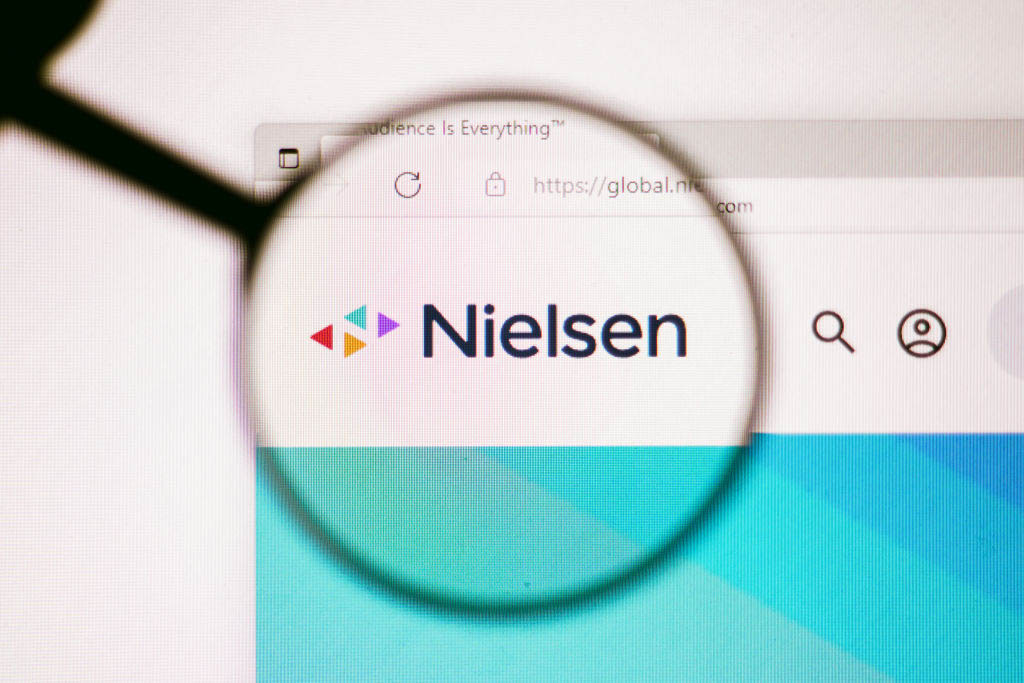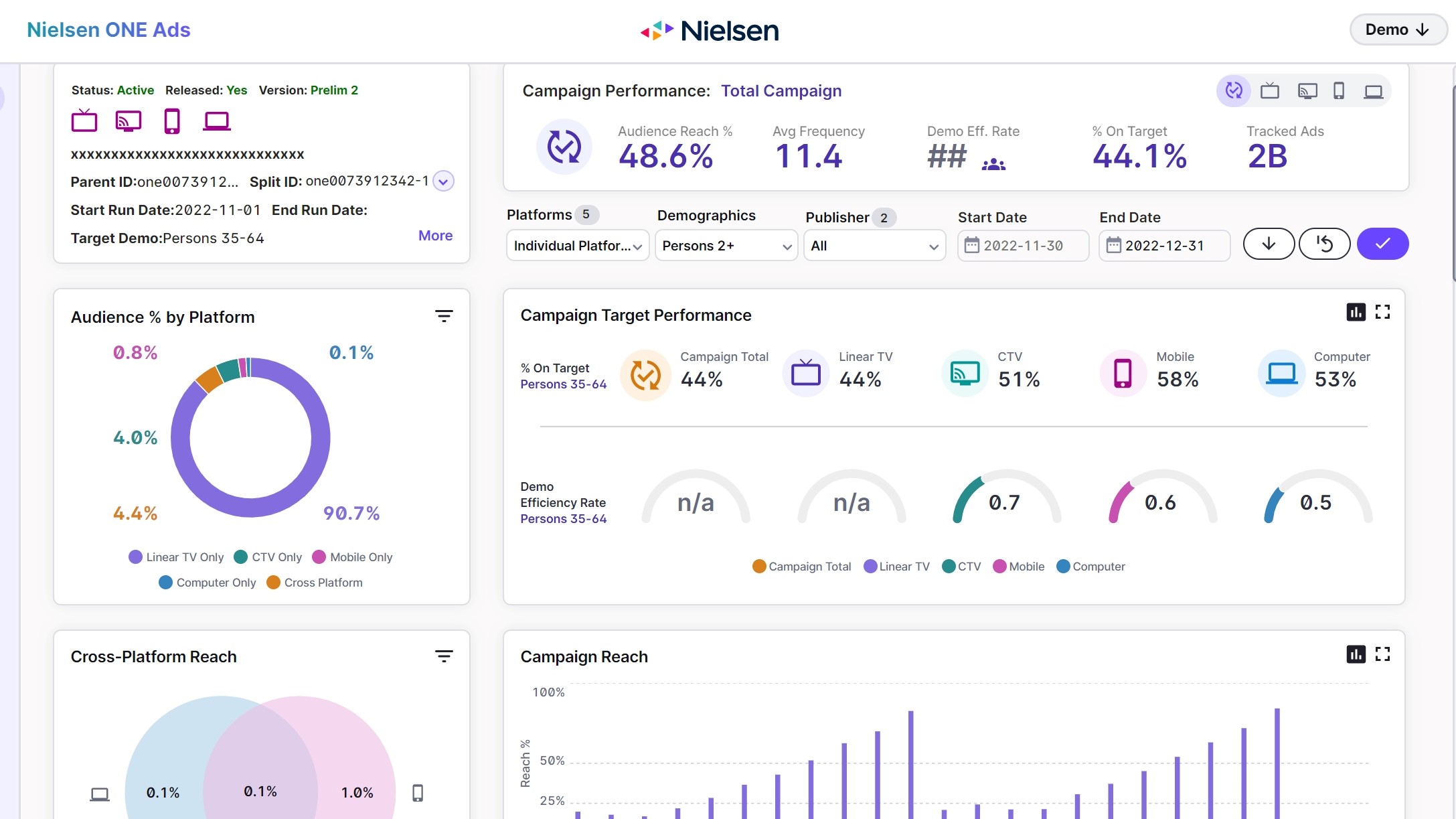Nielsen One Ready To Roll, Minus a Feature or Two
Big data, exact commercial measurement not available to be used for transactions

Nielsen said it is ready to roll out Nielsen One Ads, its new system for measuring how many people see ad campaigns, on January 11.
The new system has been designed to provide a consistent, comparable and deduplicated view of ads across screens. Nielsen also recently introduced an Alpha version of Nielsen One for Content, which measures how many people are watching content across platforms and devices.
The proliferation of new devices and new ways for people to consume content has created a much more fragmented and complicated media world, Nielsen senior VP of product management Kim Gilberti noted.
“This fragmentation really created a challenge for the industry where it’s imperative to really understand who you’re reaching, how often you’re reaching them and one what platforms,” Gilberti said during a Zoom conference with reporters.
“Whether you’re a publisher, whether you’re an advertiser, whether you’re a brand, you really need to be able to understand your audience across all these different sources in a way that’s truly comparable,” Gilberti said.

“What we want to be able to do is create a world where there are consistent metrics that are deduplicated across all these different platforms so that we are accounting for a consumer’s total viewing behavior,” she said. “So our mission, and really what our objective is, is to bring clarity, to bring simplicity, to this very complicated world of media and Nielsen One really is the road to how we get there.”
Ultimately, she said, Nielsen One will “allow advertisers and publishers to plan and to transact on a single set of metrics across linear and digital. And those metrics are reliable, independent and standardized across the industry and across all of those different platforms.”
Broadcasting & Cable Newsletter
The smarter way to stay on top of broadcasting and cable industry. Sign up below
Nielsen originally announced Nielsen One in December of 2020, saying it would launch in the fourth quarter of 2022. Nielsen then said Nielsen One would combine big data with its famous panel of households and shift the focus of advertising measurement from average commercial minute per program to evaluative viewing for individual commercials on a second-by-second basis.
A lot has changed at Nielsen since 2020. The company was recently sold to a consortium of private-equity investors for $16 billion and a cadre of senior executives have left.

When Nielsen One is initially released, Gilberti said, it will have three data sets available, only one of which will be usable for buying and selling. That data set will use linear-TV data based on “today’s average minute-based currency,” she said. “Any of the cross-platform metrics that use the linear TV component based on average minute audience can be used for buying and selling.”
Nielsen did not respond to questions asking if digital ads will be compared using the same average-based currency or how the new linear measurement was different from the current C3 system. Also unanswered was whether Nielsen would continue to produce the C3 commercial-rating metric.
Gilberti said Nielsen One would also provide “for insights purposes impact data” for two other variations of linear television. One will indicate how viewing numbers will change once big data is integrated into linear television. “The other takes that a step further and says, what will the numbers look like when linear television is measured at the sub-minute level?”
Accreditation for Nielsen’s current national-TV linear measurement system was suspended last year by the Media Rating Council after it was determined the company was undercounting views during the pandemic. Nielsen has been trying to get the accreditation restored but has not yet been successful.
Also: Byron Allen Sues Nielsen Claiming Billion-Dollar Fraud
In August, Nielsen said its system for incorporating “big data” from set-top boxes and smart TVs wasn’t ready to be used for making transactions. An MRC audit of the system was postponed. The company had planned to begin incorporating big data into its ratings in September.
Introducing the Dashboard
Nielsen One users will be able to see how their campaigns are performing across screens through a new dashboard.
At the top of the dashboard are numbers showing reach, frequency and on-target percent for a specific campaign across linear TV, connected TV, computer and mobile. Users will be able to see the individual performance of each platform within the campaign, so they’ll be able to gauge the strength of the campaign as a whole while also understanding where the audience is within it, Gilberti said.
Nielsen measurement is able to account for co-viewing on the big screen and has the capacity to measure when multiple people are viewing together.
Nielsen customers have been attending “boot camps” aimed at getting them familiar with Nielsen One and the new interface.
In addition to the graphical interfaces on the dashboard, Nielsen One users will be able to get data feeds that can be ingested into third-party systems, Gilberti said.
“There will also be a report-generation tool as part of this application, as well,“ she said. “So if people want more of the raw data, they'll have the ability to do that, but they'll also have the ability to look at the data visualizations as well.”
Nielsen One launches as new competitors using technology and big data are offering what they say is more granular and accurate viewing data for a lower price than Nielsen charges. Several media companies have said they plan to transact using data from companies like iSpot.TV, VideoAmp and Comscore, at least on an experimental basis.
Nielsen has a number of advantages over those would-be rivals, Gilberti said, including its panel of Nielsen homes in which people push buttons to indicate what they’re watching and which device they’re using.
Nielsen has “a really strong truth set in our panel that can be used to calibrate and adjust big data,” she said.
“We essentially combine the scale that big data can share and the granular insights that big data can share, but we validate it and we calibrate it using our people-based panels,” Gilberti said. “It allows us to associate viewing with people and not just devices. So, really understanding who is behind the screen, in particular, becomes really important. “ ■
Jon has been business editor of Broadcasting+Cable since 2010. He focuses on revenue-generating activities, including advertising and distribution, as well as executive intrigue and merger and acquisition activity. Just about any story is fair game, if a dollar sign can make its way into the article. Before B+C, Jon covered the industry for TVWeek, Cable World, Electronic Media, Advertising Age and The New York Post. A native New Yorker, Jon is hiding in plain sight in the suburbs of Chicago.

